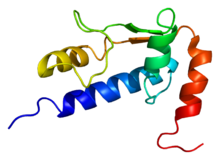- GTF2I
-
Factor de transcripción general II-I 
Estructura tridimensional de la proteína GTF2I.HUGO 4659 Símbolo GTF2I Símbolos alt. WBS, BAP-135, BAP135, BTKAP1, DIWS, IB291, SPIN, TFII-I, WBSCR6 Datos genéticos Locus Cr. 7 q11.23 Bases de datos Entrez 2969 OMIM 601679 PDB 1q60 RefSeq XP_001130609 El factor de transcripción general II-I (GTF2I) es una proteína codificada en humanos por el gen gtf2I.[1] [2] [3]
Este factor de transcripción es una fosfoproteína multifuncional con un importante papel en transcripción y en transducción de señales. Se encuentra delecionado en el síndrome de Williams-Beuren, un desorden del desarrollo a nivel multisistémico causado por la deleción de los genes contiguos en el locus cromosómico 7q11.23. Los exones codifican que codifican el 5' UTR aún no han sido completamente caracterizados, pero este gen es conocido por poseer al menos 34 exones, siendo capaz de generar cuatro variantes transcripcionales mediante splicing alternativo.[3]
Interacciones
La proteína GTF2I ha demostrado ser capaz de interaccionar con:
- USF1[4] [5]
- Histona deacetilasa 2[6] [7]
- PRKG1[8]
- Myc[9]
- MAPK3[10]
- HDAC3[7] [11]
- Factor de respuesta al suero[1] [12]
- Tirosina quinasa de Bruton[13] [14] [2]
Referencias
- ↑ a b Grueneberg DA, Henry RW, Brauer A, Novina CD, Cheriyath V, Roy AL, Gilman M (Nov 1997). «A multifunctional DNA-binding protein that promotes the formation of serum response factor/homeodomain complexes: identity to TFII-I». Genes Dev 11 (19): pp. 2482–93. PMID 9334314.
- ↑ a b Yang W, Desiderio S (Mar 1997). «BAP-135, a target for Bruton's tyrosine kinase in response to B cell receptor engagement». Proc Natl Acad Sci U S A 94 (2): pp. 604–9. PMID 9012831.
- ↑ a b «Entrez Gene: GTF2I general transcription factor II, i».
- ↑ Roy, A L; Du H, Gregor P D, Novina C D, Martinez E, Roeder R G (Dec. 1997). «Cloning of an inr- and E-box-binding protein, TFII-I, that interacts physically and functionally with USF1». EMBO J. (ENGLAND) 16 (23): pp. 7091–104. doi:. ISSN 0261-4189. PMID 9384587.
- ↑ Roy, A L; Meisterernst M, Pognonec P, Roeder R G (Nov. 1991). «Cooperative interaction of an initiator-binding transcription initiation factor and the helix-loop-helix activator USF». Nature (ENGLAND) 354 (6350): pp. 245–8. doi:. ISSN 0028-0836. PMID 1961251.
- ↑ Hakimi, Mohamed-Ali; Dong Yuanshu, Lane William S, Speicher David W, Shiekhattar Ramin (Feb. 2003). «A candidate X-linked mental retardation gene is a component of a new family of histone deacetylase-containing complexes». J. Biol. Chem. (United States) 278 (9): pp. 7234–9. doi:. ISSN 0021-9258. PMID 12493763.
- ↑ a b Wen, Yu-Der; Cress W Douglas, Roy Ananda L, Seto Edward (Jan. 2003). «Histone deacetylase 3 binds to and regulates the multifunctional transcription factor TFII-I». J. Biol. Chem. (United States) 278 (3): pp. 1841–7. doi:. ISSN 0021-9258. PMID 12393887.
- ↑ Casteel, Darren E; Zhuang Shunhui, Gudi Tanima, Tang Julian, Vuica Milena, Desiderio Stephen, Pilz Renate B (Aug. 2002). «cGMP-dependent protein kinase I beta physically and functionally interacts with the transcriptional regulator TFII-I». J. Biol. Chem. (United States) 277 (35): pp. 32003–14. doi:. ISSN 0021-9258. PMID 12082086.
- ↑ Roy, A L; Carruthers C, Gutjahr T, Roeder R G (Sep. 1993). «Direct role for Myc in transcription initiation mediated by interactions with TFII-I». Nature (ENGLAND) 365 (6444): pp. 359–61. doi:. ISSN 0028-0836. PMID 8377829.
- ↑ Kim, D W; Cochran B H (Feb. 2000). «Extracellular signal-regulated kinase binds to TFII-I and regulates its activation of the c-fos promoter». Mol. Cell. Biol. (UNITED STATES) 20 (4): pp. 1140–8. ISSN 0270-7306. PMID 10648599.
- ↑ Tussié-Luna, María Isabel; Bayarsaihan Dashzeveg, Seto Edward, Ruddle Frank H, Roy Ananda L (Oct. 2002). «Physical and functional interactions of histone deacetylase 3 with TFII-I family proteins and PIASxbeta». Proc. Natl. Acad. Sci. U.S.A. (United States) 99 (20): pp. 12807–12. doi:. ISSN 0027-8424. PMID 12239342.
- ↑ Kim, D W; Cheriyath V, Roy A L, Cochran B H (Jun. 1998). «TFII-I enhances activation of the c-fos promoter through interactions with upstream elements». Mol. Cell. Biol. (UNITED STATES) 18 (6): pp. 3310–20. ISSN 0270-7306. PMID 9584171.
- ↑ Sacristán, Catarina; Tussié-Luna María Isabel, Logan Sheila M, Roy Ananda L (Feb. 2004). «Mechanism of Bruton's tyrosine kinase-mediated recruitment and regulation of TFII-I». J. Biol. Chem. (United States) 279 (8): pp. 7147–58. doi:. ISSN 0021-9258. PMID 14623887.
- ↑ Novina, C D; Kumar S, Bajpai U, Cheriyath V, Zhang K, Pillai S, Wortis H H, Roy A L (Jul. 1999). «Regulation of nuclear localization and transcriptional activity of TFII-I by Bruton's tyrosine kinase». Mol. Cell. Biol. (UNITED STATES) 19 (7): pp. 5014–24. ISSN 0270-7306. PMID 10373551.
Enlaces externos
Categorías:- Genes del cromosoma 7
- Factores de transcripción
Wikimedia foundation. 2010.
